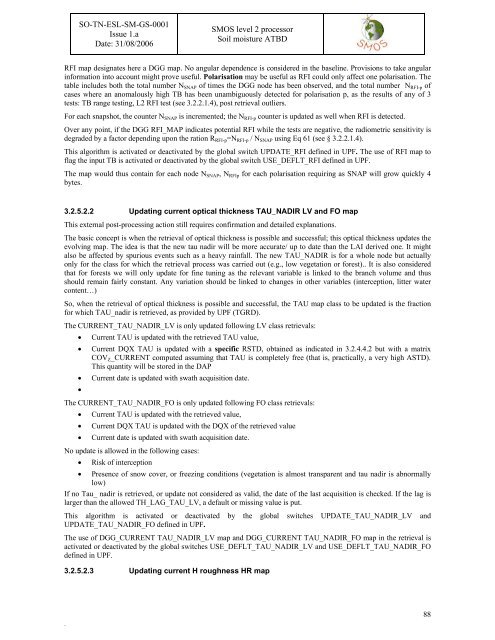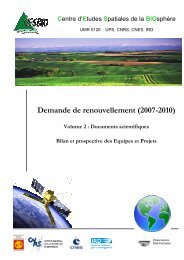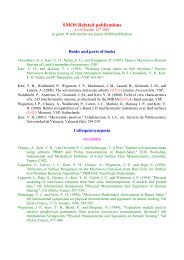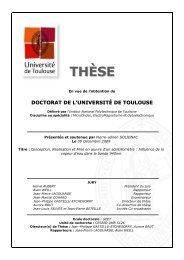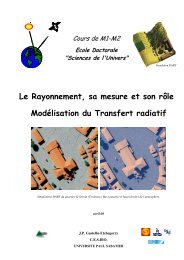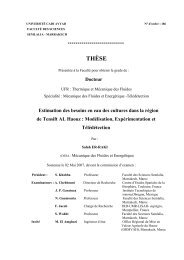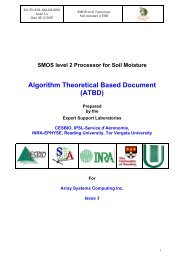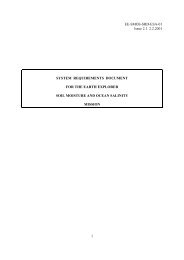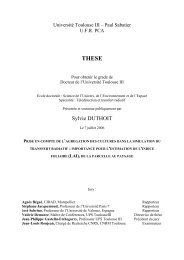Algorithm Theoretical Based Document (ATBD) - CESBIO
Algorithm Theoretical Based Document (ATBD) - CESBIO
Algorithm Theoretical Based Document (ATBD) - CESBIO
Create successful ePaper yourself
Turn your PDF publications into a flip-book with our unique Google optimized e-Paper software.
SO-TN-ESL-SM-GS-0001<br />
Issue 1.a<br />
Date: 31/08/2006<br />
SMOS level 2 processor<br />
Soil moisture <strong>ATBD</strong><br />
RFI map designates here a DGG map. No angular dependence is considered in the baseline. Provisions to take angular<br />
information into account might prove useful. Polarisation may be useful as RFI could only affect one polarisation. The<br />
table includes both the total number N SNAP of times the DGG node has been observed, and the total number N RFI-p of<br />
cases where an anomalously high TB has been unambiguously detected for polarisation p, as the results of any of 3<br />
tests: TB range testing, L2 RFI test (see 3.2.2.1.4), post retrieval outliers.<br />
For each snapshot, the counter N SNAP is incremented; the N RFI-p counter is updated as well when RFI is detected.<br />
Over any point, if the DGG RFI_MAP indicates potential RFI while the tests are negative, the radiometric sensitivity is<br />
degraded by a factor depending upon the ration R RFI-p =N RFI-p / N SNAP using Eq 61 (see § 3.2.2.1.4).<br />
This algorithm is activated or deactivated by the global switch UPDATE_RFI defined in UPF. The use of RFI map to<br />
flag the input TB is activated or deactivated by the global switch USE_DEFLT_RFI defined in UPF.<br />
The map would thus contain for each node N SNAP , N RFIp for each polarisation requiring as SNAP will grow quickly 4<br />
bytes.<br />
3.2.5.2.2 Updating current optical thickness TAU_NADIR LV and FO map<br />
This external post-processing action still requires confirmation and detailed explanations.<br />
The basic concept is when the retrieval of optical thickness is possible and successful; this optical thickness updates the<br />
evolving map. The idea is that the new tau nadir will be more accurate/ up to date than the LAI derived one. It might<br />
also be affected by spurious events such as a heavy rainfall. The new TAU_NADIR is for a whole node but actually<br />
only for the class for which the retrieval process was carried out (e.g., low vegetation or forest).. It is also considered<br />
that for forests we will only update for fine tuning as the relevant variable is linked to the branch volume and thus<br />
should remain fairly constant. Any variation should be linked to changes in other variables (interception, litter water<br />
content…)<br />
So, when the retrieval of optical thickness is possible and successful, the TAU map class to be updated is the fraction<br />
for which TAU_nadir is retrieved, as provided by UPF (TGRD).<br />
The CURRENT_TAU_NADIR_LV is only updated following LV class retrievals:<br />
• Current TAU is updated with the retrieved TAU value,<br />
• Current DQX TAU is updated with a specific RSTD, obtained as indicated in 3.2.4.4.2 but with a matrix<br />
COV Z _CURRENT computed assuming that TAU is completely free (that is, practically, a very high ASTD).<br />
This quantity will be stored in the DAP<br />
• Current date is updated with swath acquisition date.<br />
•<br />
The CURRENT_TAU_NADIR_FO is only updated following FO class retrievals:<br />
• Current TAU is updated with the retrieved value,<br />
• Current DQX TAU is updated with the DQX of the retrieved value<br />
• Current date is updated with swath acquisition date.<br />
No update is allowed in the following cases:<br />
• Risk of interception<br />
• Presence of snow cover, or freezing conditions (vegetation is almost transparent and tau nadir is abnormally<br />
low)<br />
If no Tau_ nadir is retrieved, or update not considered as valid, the date of the last acquisition is checked. If the lag is<br />
larger than the allowed TH_LAG_TAU_LV, a default or missing value is put.<br />
This algorithm is activated or deactivated by the global switches UPDATE_TAU_NADIR_LV and<br />
UPDATE_TAU_NADIR_FO defined in UPF.<br />
The use of DGG_CURRENT TAU_NADIR_LV map and DGG_CURRENT TAU_NADIR_FO map in the retrieval is<br />
activated or deactivated by the global switches USE_DEFLT_TAU_NADIR_LV and USE_DEFLT_TAU_NADIR_FO<br />
defined in UPF.<br />
3.2.5.2.3 Updating current H roughness HR map<br />
.<br />
88


